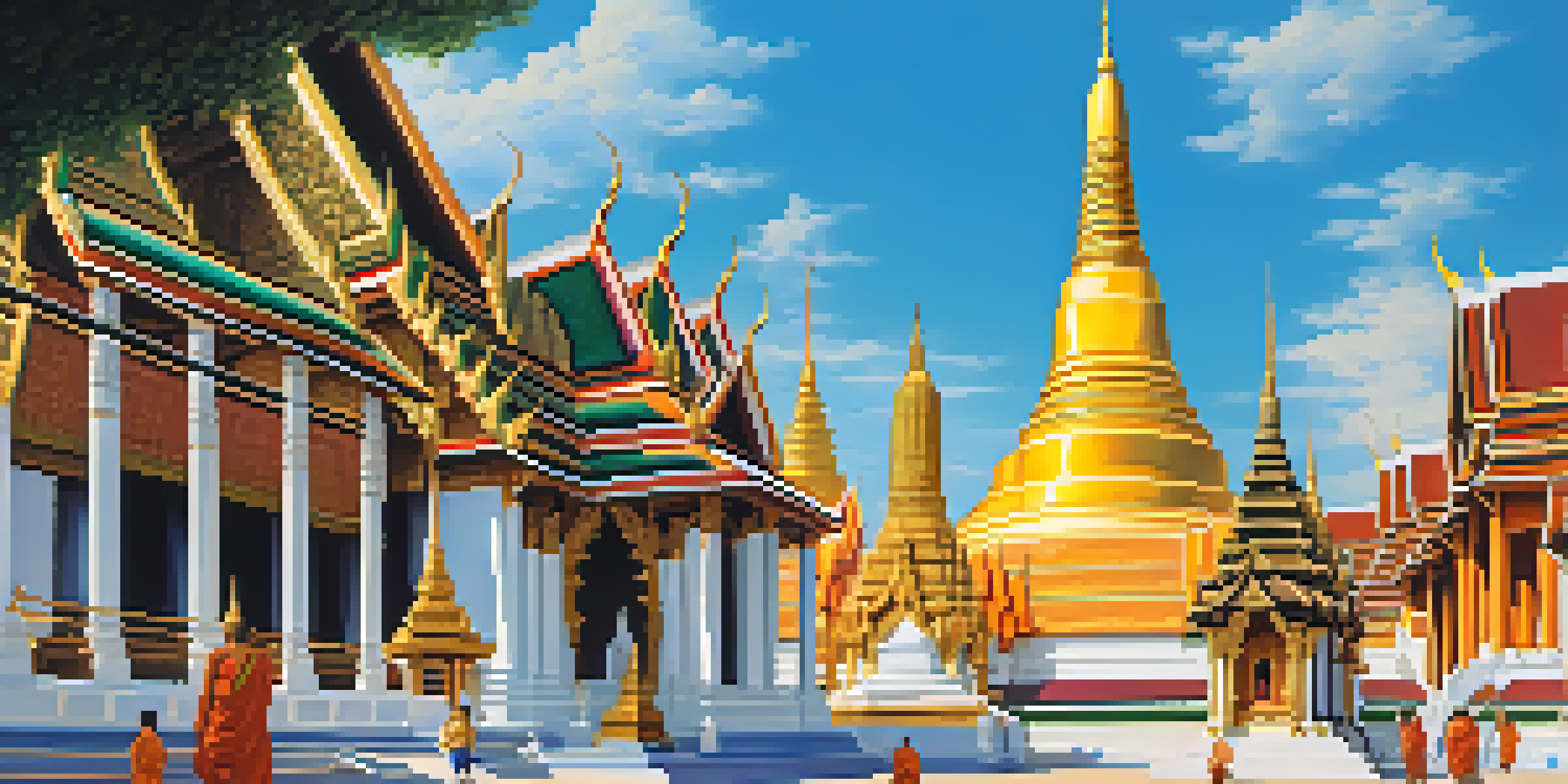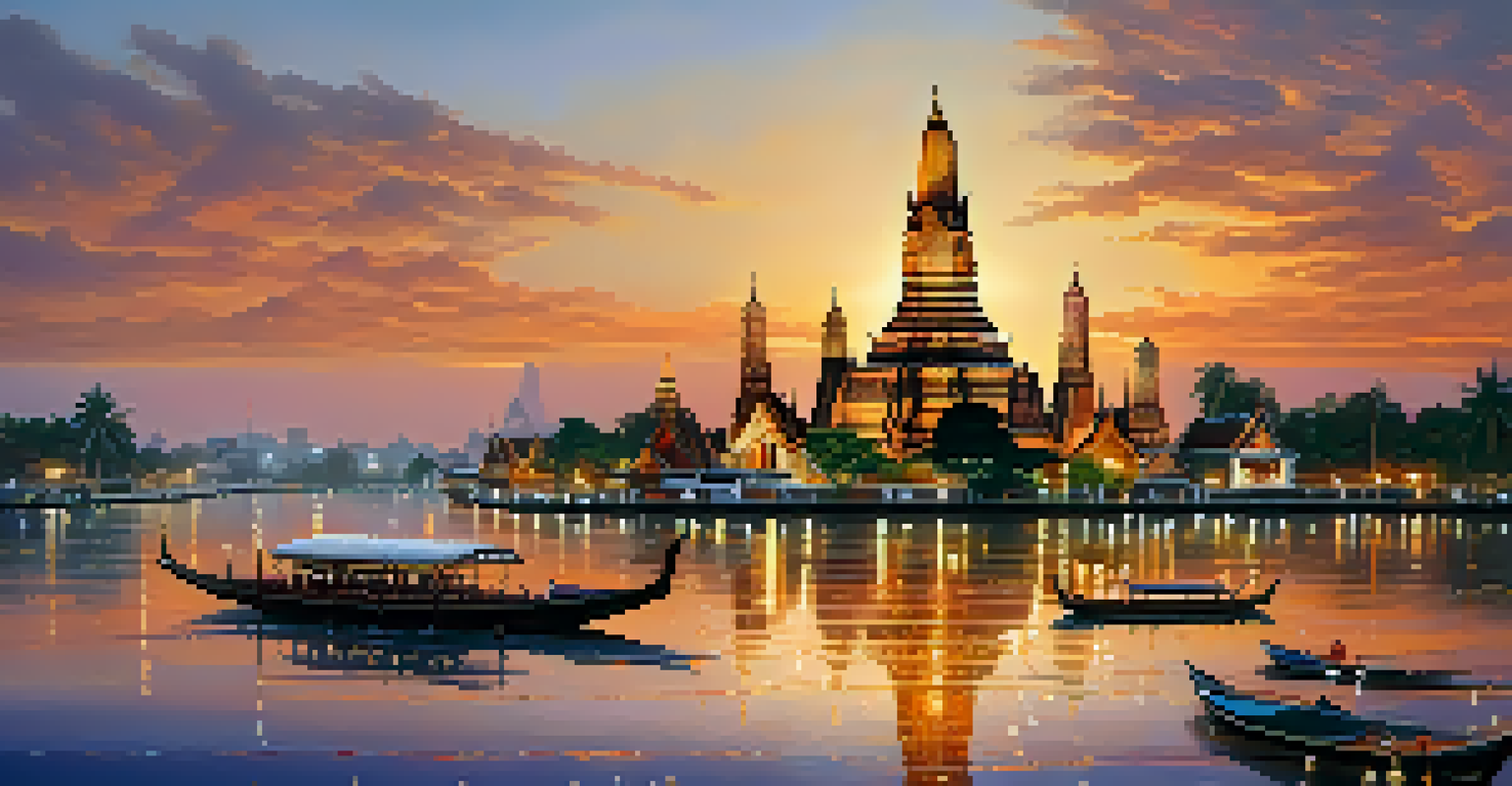Exploring Thailand's Temples: Architectural Wonders and Stories

An Overview of Thailand's Rich Temple Heritage
Thailand is home to thousands of temples, known as 'wats,' which reflect the country's deep cultural and spiritual heritage. Each temple showcases unique architectural styles, vibrant decorations, and profound historical significance. These sacred sites are not just places of worship but also serve as symbols of Thai identity and pride.
Temples are not just places of worship; they are the heart and soul of the community, where faith and culture intertwine.
From the intricate designs of the northern temples to the grandeur of those in Bangkok, each region has its own distinct style. Visitors often find themselves captivated by the intricate murals, statues, and the serene atmosphere of these sacred spaces. Understanding the history behind these temples enhances the appreciation of their beauty.
As you explore, you'll discover that each temple tells a story, revealing insights into Thailand's past, beliefs, and traditions. They stand as a testament to the country's enduring spirituality and artistic expression, inviting travelers to immerse themselves in their rich narratives.
Wat Phra Kaew: The Emerald Buddha Temple
Located within the grounds of the Grand Palace in Bangkok, Wat Phra Kaew is one of Thailand's most revered temples. It is famous for housing the Emerald Buddha, a highly revered statue made of jade that symbolizes the unity of Thailand. The temple's impressive architecture, adorned with intricate details, attracts visitors from around the globe.

The temple complex features stunning mosaics, golden stupas, and ornate murals that depict tales from the Ramayana. Walking through the grounds, one can’t help but feel a sense of awe and reverence. The atmosphere is often filled with the sound of monks chanting, adding to the spiritual ambiance of the place.
Thailand's Rich Temple Heritage
Thailand's temples, or 'wats,' are vital cultural symbols that showcase the country's deep spiritual roots and architectural diversity.
Visiting Wat Phra Kaew offers not just a visual feast but also a journey into the heart of Thai spirituality. It’s a reminder of the importance of Buddhism in Thai culture and serves as a hub for ceremonies and celebrations that connect the past with the present.
Wat Pho: Home of the Reclining Buddha
Just a stone's throw away from Wat Phra Kaew, Wat Pho is famous for its colossal Reclining Buddha statue, which measures an impressive 46 meters long. This temple is one of the oldest in Bangkok and is considered the birthplace of traditional Thai massage. As you stroll through its grounds, you’ll encounter an array of beautiful stupas and intricate murals.
In every walk with nature, one receives far more than he seeks.
Wat Pho is not just a visual wonder; it also serves as a center for learning. The temple houses a school for traditional Thai massage, where visitors can experience the healing arts first-hand. This blend of spirituality and wellness is part of what makes Wat Pho so special.
The temple's tranquil atmosphere invites reflection, making it an ideal spot to relax after the hustle and bustle of Bangkok. Whether you're exploring its historical significance or simply enjoying the beauty, Wat Pho provides a truly enriching experience.
The Majestic Wat Arun: Temple of Dawn
Wat Arun, also known as the Temple of Dawn, is a stunning riverside temple that captures the imagination with its towering spires. Its central prang (tower) is adorned with colorful porcelain and seashells, making it a striking sight, especially during sunrise or sunset. The temple's unique design reflects the Khmer influence and is a symbol of Thailand's architectural evolution.
Climbing to the top of the central prang rewards visitors with panoramic views of the Chao Phraya River and the city skyline. The journey up the steep steps can be a bit daunting, but the breathtaking vistas are well worth the effort. This experience connects visitors not just with the beauty of the temple but also with the vibrant life along the river.
Wat Phra Kaew's Spiritual Significance
Wat Phra Kaew, home to the revered Emerald Buddha, exemplifies the intersection of Thai spirituality and historical grandeur.
Wat Arun represents the transition between the physical and spiritual worlds, embodying the Buddhist concept of enlightenment. Its picturesque setting and intricate design make it a must-visit destination for anyone traveling in Thailand.
Exploring the Ancient City of Ayutthaya
Just north of Bangkok lies the ancient city of Ayutthaya, a UNESCO World Heritage Site that was once the capital of the Kingdom of Siam. The ruins of its temples, such as Wat Chaiwatthanaram and Wat Mahathat, tell tales of grandeur and resilience. Walking through this historical site feels like stepping back in time, as you explore the remnants of a once-thriving civilization.
The temples showcase a blend of Siamese, Khmer, and Burmese architectural styles, reflecting the cultural exchanges that occurred over centuries. The iconic Buddha head entwined in tree roots at Wat Mahathat is a poignant reminder of nature reclaiming history. Each structure carries stories of glory and downfall, inviting visitors to ponder the passage of time.
Ayutthaya's temples are not only beautiful but also hold significant historical importance. They provide valuable insights into Thailand's rich heritage and the influences that have shaped its culture over the years. A visit to Ayutthaya is an enriching experience that complements the vibrant life of modern Thailand.
The Serene Beauty of Wat Phra That Doi Suthep
Perched on a mountain overlooking Chiang Mai, Wat Phra That Doi Suthep is a sacred site that offers breathtaking views and spiritual significance. The temple, built in the 14th century, is an important pilgrimage destination for Thai Buddhists. Its golden chedi (stupa) glistens in the sunlight, creating a striking contrast against the lush greenery of the surrounding mountains.
Visitors often embark on a journey to this temple, either by hiking up the sacred path or taking a cable car. The climb is rewarded with not just stunning views but also a deep sense of peace and spirituality. Inside the temple complex, the atmosphere is filled with the sounds of chanting and the scent of incense, creating a truly immersive experience.
Temples as Community Hubs
Thai temples serve not only as places of worship but also as community centers that foster social connections and provide educational opportunities.
Wat Phra That Doi Suthep serves as a reminder of the deep connection between nature and spirituality in Thai culture. It's a place where one can reflect and recharge, surrounded by beauty and tranquility. The temple's significance extends beyond its physical presence, embodying the essence of faith and devotion.
Wat Saket: The Golden Mount
Wat Saket, or the Golden Mount, is a unique temple situated on a man-made hill in Bangkok. The temple's golden chedi is visible from afar and attracts many visitors who seek to climb its 300 steps for a rewarding view of the city. This temple is particularly popular during the Loy Krathong festival when it's beautifully illuminated.
The ascent to the top is lined with lush greenery and sacred bells, creating a serene environment for reflection. As you climb, you can pause to admire the various statues and shrines that tell stories of Buddha’s teachings. The journey up is as enriching as the destination itself.

At the summit, you'll find a peaceful atmosphere where you can take in the panoramic views of Bangkok. Wat Saket serves as a reminder of the spiritual journey we all undertake, symbolizing the climb towards enlightenment amidst the busyness of urban life.
The Role of Temples in Thai Culture and Society
Temples in Thailand serve as more than just places of worship; they are integral to the community and culture. They often act as centers for social gatherings, festivals, and educational activities, fostering a sense of community among locals. Temples also provide essential services, such as healthcare and support for those in need.
Many temples offer meditation and mindfulness courses, helping people connect with their inner selves and the teachings of Buddhism. This blending of spirituality and daily life illustrates how deeply woven temples are into the fabric of Thai society. They provide spaces for reflection, learning, and connection with others.
As you explore Thailand's temples, you'll witness the harmony between spirituality and everyday life. This cultural richness is what makes Thailand's temples not just architectural wonders but also vital parts of the community's heart and soul.